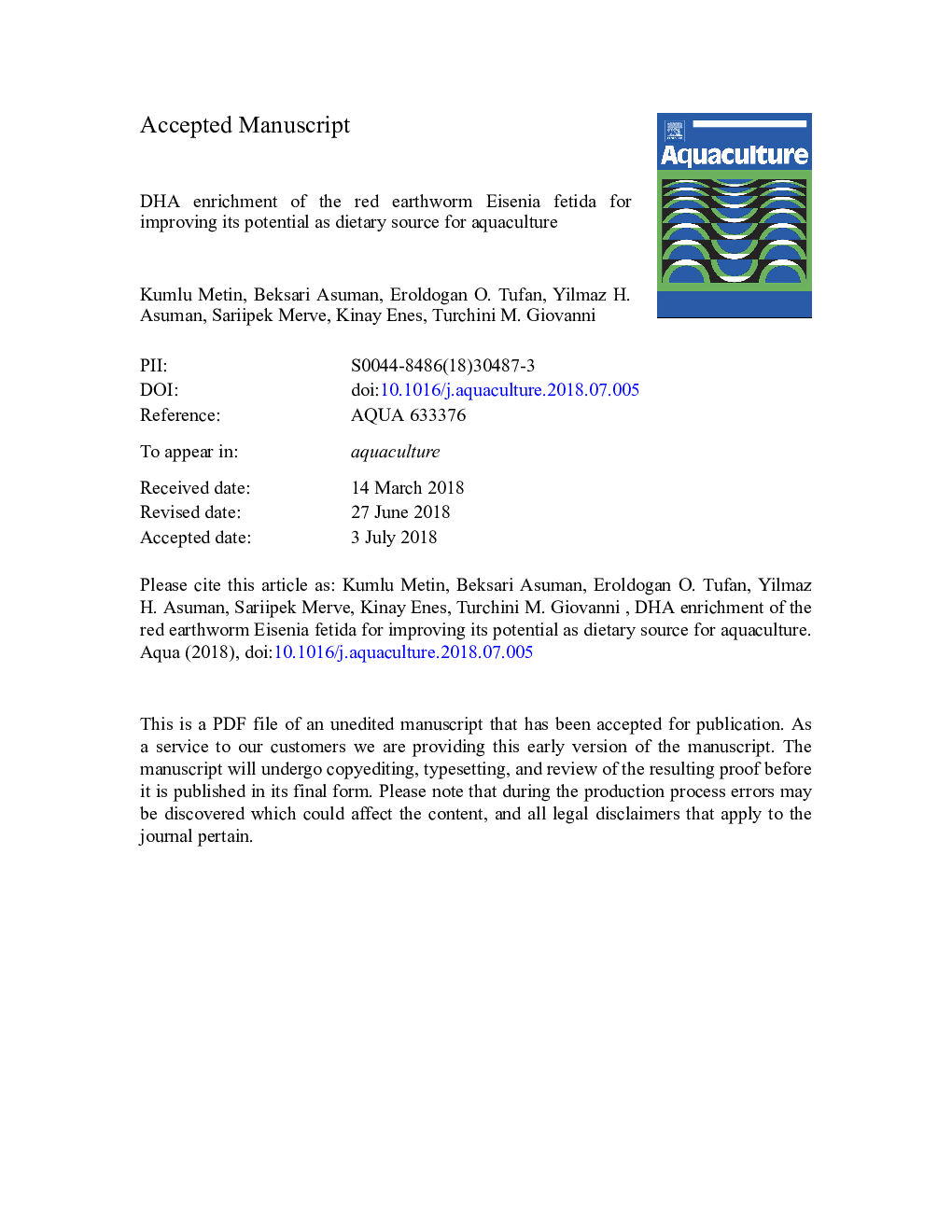| کد مقاله | کد نشریه | سال انتشار | مقاله انگلیسی | نسخه تمام متن |
|---|---|---|---|---|
| 8492928 | 1552792 | 2018 | 32 صفحه PDF | دانلود رایگان |
عنوان انگلیسی مقاله ISI
DHA enrichment of the red earthworm Eisenia fetida for improving its potential as dietary source for aquaculture
دانلود مقاله + سفارش ترجمه
دانلود مقاله ISI انگلیسی
رایگان برای ایرانیان
کلمات کلیدی
موضوعات مرتبط
علوم زیستی و بیوفناوری
علوم کشاورزی و بیولوژیک
علوم آبزیان
پیش نمایش صفحه اول مقاله

چکیده انگلیسی
This study aimed at assessing the potential of omega-3 fatty acids enrichment in the red earthworm Eisenia fetida. Specifically, the investigation focused on the effects of a commercial enrichment emulsion (ES) supplied at graded doses (0, 10, 25 and 50â¯g ES/100â¯g of compost) and at different enrichment times (0, 12, 24, 48 and 96â¯h) on the resulting fatty acids composition of red earthworm reared with or without additional bedding materials. In the first experiment (bed-free technique), inclusion of ES, in the highest tested dose (50â¯g/100â¯g compost), exerted stress on the earthworms resulting in high mortality, while the use of bedding in the second experiment led to safer but slightly reduced enrichment. Dominant fatty acids in earthworms were found to be PUFA (51.08-53.04â¯mol%), followed by MUFA (25.95-26.90â¯mol%) and SFA (21.16-22â¯mol%). Non-enriched earthworms contained some of the PUFA, important for cultured marine species, including 18:2n-6, 18:3n-3 and 20:5n-3 (EPA), whereas in contrast, 22:6n-3 (DHA) is very low. Overall the results of this study have, for the first time, showed that LC-PUFA, and especially DHA, contents of E. fetida can be enriched to levels much higher than those of the control (non-enriched) groups. In bed-free technique, DHA accumulation in the worms increased from 0.31â¯mol% (0â¯h) to 14.38-14.63â¯mol% at 12â¯h, 9.65-9.81â¯mol% at 24â¯h, 10.65-15.41â¯mol% at 48â¯h and finally 15.81-18.31â¯mol% at 96â¯h. In the bedding technique, DHA also rose from the base level to 5.27-5.97â¯mol% at 12â¯h, 5.25-8.60â¯mol% at 24â¯h, 11.06-13.01â¯mol% at 48â¯h and finally 14.05-17.14â¯mol% at 96â¯h. In the bedding technique, DHA increased linearly for up to 9.6 fold, while this increase was fluctuating in the bed-free technique, reaching 8.7 fold over the non-enriched controls. Throughout the experiments, n-3/n-6 ratios rose from 1.35-1.56 in the controls to 3.38-3.72 in the enriched-groups. As a result, 12-h enrichment time is suggested to be suitable for a fast boosting of DHA in the earthworms with bed-free technique, while a longer period of up to 96â¯h is recommended with bedding technique at optimal dose of 25â¯g ES inclusion into 100â¯g compost. The present study showed that earthworm (E.fetida) can be successfully enriched in its DHA content; making it a novel and easily producible feed resource, particularly as broodstock feed, in aquatic hatcheries.
ناشر
Database: Elsevier - ScienceDirect (ساینس دایرکت)
Journal: Aquaculture - Volume 496, 1 November 2018, Pages 10-18
Journal: Aquaculture - Volume 496, 1 November 2018, Pages 10-18
نویسندگان
Metin Kumlu, Asuman Beksari, O. Tufan EroldoÄan, H. Asuman Yılmaz, Merve Sarıipek, Enes Kınay, Giovanni M. Turchini,